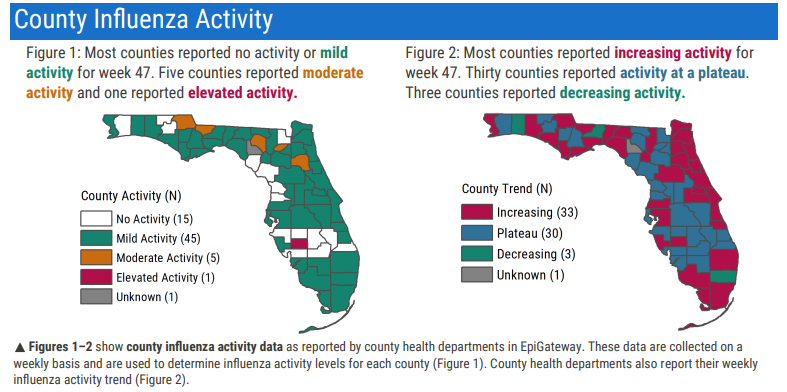What’s Going Around FL? Flu, ‘Super Cold,’ COVID-19
FLORIDA — Though the number of new COVID-19 cases has dropped significantly in Florida since this summer’s surge, which was largely driven by the emergence of the delta coronavirus variant, residents and visitors still need to remain alert when it comes to threats to their health.
Not only was the latest coronavirus variant, omicron, detected in Florida for the first time Tuesday, but other illnesses — including the cold, flu and respiratory syncytial virus (RSV) — are popping up in various areas across the state.
Just under 11,000 new COVID-19 cases were reported in the state during the week of Nov. 26 through Dec. 2, according to data from the Florida Department of Health. That’s a far cry from this summer, when tens of thousands of cases were sometimes reported in a single day and some weeks saw more than 150,000 new cases.
Still, the omicron variant, which was confirmed at the James A. Haley Veterans’ Hospital in Tampa on Tuesday, has many people on edge across the globe and in Florida, especially as the 2021-22 cold and flu season arrives in the Sunshine State.
Much remains unknown about omicron, including whether it is more contagious, as some health authorities suspect, whether it can thwart vaccines and whether it makes people as sick as the original strain, according to the Associated Press.
At the same time, “influenza-like illness” activity is increasing throughout the state, according to DOH data for the week of Nov. 21-27, the most recent week with this information available.
While the percent of emergency department and urgent care center visits with discharge diagnoses show low rates of the flu in recent weeks, that rate is increasing for the first time since March 2020 — the start of the COVID-19 pandemic — the DOH said.
A total of 33 counties — about half the counties in the state — saw an increase in flu cases that week.

According to the Walgreens Flu Index for the week ending in Dec. 4, Florida ranked No. 16 for states and territories with flu activity. The map is compiled using retail data for antiviral flu medication prescriptions filled at Walgreens locations across the country on a weekly basis.
In mid-November, just before Thanksgiving, Tallahassee led the nation for the highest amount of flu activity based on this index, WCTV reported. This was driven by outbreaks at Florida State University and Florida A&M University campuses, U.S. News said. The state capital has since dropped off Walgreens’ list of top 10 metropolitan areas showing flu activity.
Small flu outbreaks have recently been tracked in some Florida counties recently, including Hillsborough, Pinellas and Pasco, Fox 13 said. Flu is also on the rise in South Florida, doctors told WPBF.
Doctors at Tallahassee Memorial HealthCare said that because the number of flu cases was so low in Florida last year because of the pandemic, when many people wore masks or were social distancing, there’s little natural immunity among state residents. For this reason, this year’s flu season is expected to be worse than recent years, reports said.
“Because we’ve been secluded and had less exposure, and now all of a sudden we’re out there in the world again,” said Dr. Larry Bush, an infectious disease doctor in West Palm Beach.
The dominant strain this year is influenza A, or H3N2, Dr. Michael Teng, an immunologist with USF Health, told Fox 13. He said this strain can cause more serious symptoms and breakthrough cases among those vaccinated, and suggested people get vaccinated against the flu this year.
"If you don't get the flu shot or if you get flu, even if you've gotten the shot, it tends to be a little bit more severe disease," Teng said.
Florida has the lowest flu vaccination rate in the country with just 41.7 percent of Floridians ages 6 months and older inoculated against the virus, according to data from the U.S. Centers for Disease Control and Prevention.
Some doctors say they’re also catching the flu earlier because some symptoms overlap with coronavirus.
"Now, people are so concerned it could be COVID that they're coming in, so we're able to test them earlier on," said Dr. Carolyn Pass, a physician with Optum Primary Care and the chief of staff at AdventHealth in Lake Wales.
In addition to the flu, the common cold is also going around Florida, doctors said.
One medical professional, Stacy Mills, medical director at the Boynton Beach JFK emergency room, described it as a “super cold” to CBS 12.
“We haven’t really seen any positive COVIDs in the past few weeks, they’re being tested for the flu, and they’re not positive for the flu either, so it is a super cold that’s going around in the community,” she said.
Meanwhile, it’s also the season for respiratory syncytial virus in all regions of the state. This common respiratory virus causes mild, cold-like symptoms in young children and older adults.
Though cases have been detected in Florida, RSV activity in the state is below levels typically observed during this time of year, according to data from Nov. 14-20, the DOH said.
Whether you encounter the flu or the cold this season, the best thing people can do is wash their hands to protect themselves, one doctor said. Only six outbreaks have been reported since July 25.
“Washing your hands is probably the most important advice we can give anybody,” Dr. Olayemi Osiyemi, an infectious disease doctor in West Palm Beach, said. “Because that’s how you carry germs, on your fingers or your hands and move it to somebody else.”
This article originally appeared on the Sarasota Patch

